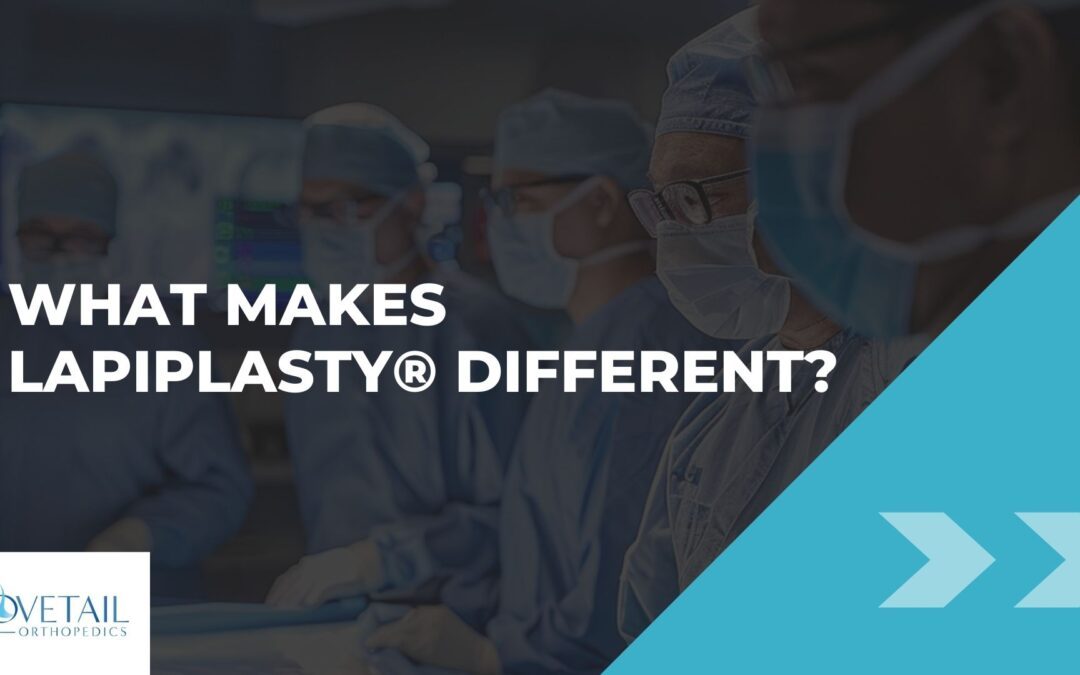The Critical Role of Training in Medical Innovation
In the fast-paced world of medical advancements, the excitement surrounding new technologies can often eclipse the equally important aspects of training and implementation. As medical companies push the boundaries of what’s possible in healthcare, the focus on the hardware and equipment can overshadow the human element of the innovation’s success. This gap in focus and training can hinder the potential impact of groundbreaking procedures, leaving healthcare professionals and patients navigating uncharted territory without a compass. In this article, we look past the technical breakthroughs of Lapiplasty® and focus on what makes Lapiplasty® bunion surgery truly unique.
A Holistic Approach to Innovation: What Makes Lapiplasty® Different
Recognizing the need for a more integrated approach to medical advancements, Dr. Santrock was drawn to Treace Medical Concepts. What set Treace apart was not just their pursuit of cutting-edge Bunion Surgery but their understanding that innovation must be holistic. To them, the science and technology are pivotal, but so is the human aspect of thoroughly training surgeons.
Crucially, Treace supports surgeons beyond the initial training, ensuring they’re not just qualified to use the equipment and perform surgeries but are continually supported throughout their practice. This approach, where surgeons must complete comprehensive training before even purchasing the equipment for Lapiplasty®, is a testament to Treace’s commitment to excellence and safety—a commitment not always typical in medical advancements.

Training: The Key to Lapiplasty®’s High Success Rates and What Makes Lapiplasty® Different
The remarkable success rates of Lapiplasty® bunion surgeries, ranging between 97 and 99%, can be attributed to the meticulous and rigorous training program mandated for all participating surgeons. This program, designed by experts at Treace Medical Concepts, ensures that every surgeon is equipped with the necessary tools and thoroughly versed in the nuances of the Lapiplasty® procedure. Let’s delve deeper into the two pivotal phases of this training program, which collectively form the backbone of Lapiplasty®’s success.
Phase 1: Laying the Theoretical Foundation
The initial phase of the training program is designed to build a solid theoretical foundation for the surgeons. This includes a detailed technical workshop with comprehensive lectures and an immersive exploration of the science and innovation driving the Lapiplasty® technique. Surgeons explore to the biomechanics of the foot, the pathology behind bunions, and the rationale behind the Lapiplasty® approach. This phase ensures that before stepping into the operating room, surgeons have a deep understanding of how to perform the procedure and why it is performed a certain way. It emphasizes the importance of precision and the critical thinking required to adapt the procedure to each patient’s unique anatomy.
Phase 2: Bridging Theory with Practice
After establishing a theoretical base, surgeons move on to the second, more hands-on phase of the training. This phase is where theoretical knowledge is put to the test through practical training. Surgeons engage in hands-on cadaver workshops, allowing them to apply their learning in a controlled environment that mimics real surgical scenarios. Additionally, simulation exercises further refine their skills, focusing on the specific maneuvers and techniques essential to the Lapiplasty® procedure. This phase is critical for developing the tactile skills necessary for surgery, enabling surgeons to feel confident in their ability to adjust and adapt the procedure as needed, ensuring optimal outcomes for each patient.
The Comprehensive Approach: A Recipe for Success
This two-phased training approach ensures that surgeons are well-prepared for the realities of performing Lapiplasty® surgeries. By the end of the program, they are not only theoretically sound but also practically proficient, capable of navigating the complexities of the procedure with ease. The training doesn’t stop at just performing a successful surgery; it encompasses managing patient expectations, understanding post-operative care, and handling complications should they arise. This holistic approach to training is what sets Lapiplasty® apart, contributing significantly to its high success rates.
Moreover, continuous education and support are provided even after the completion of the training program. Surgeons have access to a community of peers and experts for ongoing advice, case discussions, and updates on the latest research and techniques. This ensures that the level of care and expertise remains high, further solidifying the success rates of Lapiplasty® surgeries.

Dr. Santrock’s Dual Role: What Makes Lapiplasty® Different
Dr. Santrock’s involvement with the design team of Lapiplasty® and his position as a professor at WVU School of Medicine position him uniquely to lead the second phase of the training program. His dual role enhances the training, benefiting the surgeons under his supervision and enriching his own surgical practice. By teaching, he gains insights into new techniques and approaches, illustrating that surgery is far from a one-size-fits-all process. Each patient’s uniqueness requires a tailored approach, a philosophy that Dr. Santrock embodies and imparts to those he trains.
Consider Lapiplasty® with Dr. Santrock and Dovetail Orthopedics
If you’re exploring options for Lapiplasty® Bunion Surgery, consider Dr. Santrock and Dovetail Orthopedics as your choice for care. Located at 2416 Lynndale Road Suite 102, Fernandina Beach, FL 32034, our facility welcomes clients from all over, many of whom travel from out of state, seeking the unparalleled care we provide. Experience the difference that comes from a team committed not just to surgical success but to the comprehensive well-being of each patient.
Call Your Lapiplasty® Surgeon:
Phone: (904) 430-7132
Get relief from bunion discomfort with Dr. Santrock and Dovetail Orthopedics you’re not just receiving a surgical procedure but becoming part of a community dedicated to excellence in every aspect of care.

